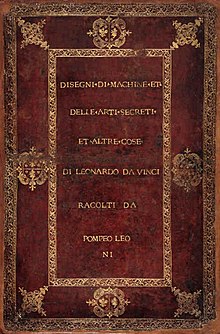Codex Atlanticus
The Codex Atlanticus ( Italian Codice Atlantico ) refers to a bound collection of drawings, sketches and notes by the Italian Renaissance artist Leonardo da Vinci (1452–1519).
Surname
The manuscript was named Codex Atlanticus because of its large atlas format . Around 1780 the work was recorded in a catalog of the Biblioteca Ambrosiana as "codice in forma atlantica". The work today consists of 1,119 sheets in the format 64.5 × 43.5 cm and is in the holdings of the Biblioteca Ambrosiana in Milan .
history
After Leonardo da Vinci's death, all of his notes passed into the hands of his pupil Francesco Melzi (around 1491/92 - around 1570), who kept the documents. His son Orazio Melzi inherited the documents in 1570 and also sold them as individual sheets and the valuable material was scattered. The sculptor and art collector Pompeo Leoni (1533-1608) was able to acquire a large part of the records.
Leoni cut up individual sheets of paper, glued together others that did not originally belong together. He summarized up to six drawings on one page by either gluing them to a backing paper or mounting them in a paper frame, similar to a passepartout , which made it possible to see the front and back of the original. As a result, this work, later referred to as “Codex Atlanticus”, contains works from a period of 40 years, from 1478 to 1518, which encompassed almost the entire artistic life of da Vinci and, in the form created by Leoni, had a volume of 481 sheets and approx 60 cm thick.
After Leoni's death in 1608, the codex came into the possession of Count Galeazzo Arconati , who donated it to the Ambrosian Library in Milan in 1637. In 1795 the work, together with twelve other manuscripts from Leonardos, was taken as spoils of Napoleon's war in the library of the Institut de France in Paris and returned to the Biblioteca Ambrosiana in 1815 after the fall of Napoleon. In 1938 Alfredo Ravasco created a bookcase made of rock crystal and lapis lazuli to store the codex.
In the 1960s the volume was dismantled, restored and reorganized so that today all drawings are mounted on a separate sheet. Since the restoration was completed in 1968, the codex has consisted of 1119 pages bound in twelve volumes.
literature
- Charles Nicholl : Leonardo da Vinci - The biography . S. Fischer, Frankfurt am Main 2006, ISBN 978-3-10-052405-8 .
- Emma Dickens (Ed.): Das da Vinci Universum - The Notebooks of Leonardo , Ullstein Verlag, Berlin 2006, ISBN 3-548-36874-3 , from 2007: ISBN 978-3-548-36874-0 .
- Carlo Pedretti : Leonardo da Vinci on Painting . University of California Press, Berkeley and Los Angeles 1964 ( digitized ).
- Theodor Lücke (Ed.): Leonardo da Vinci: Diaries and records , 3rd edition, Paul List Verlag, Leipzig 1953.
See also
Web links
- Codex Atlanticus - Museo Galileo - Institute and Museum of the History of Science - Florence, Italy , accessed January 31, 2011
- Codex Atlanticus on the website of the Biblioteca Ambrosiana , accessed in Italian on May 28, 2020
- Codex Atlanticus with transcription on the e-Leo website of the Biblioteca Leonardiana of Vinci , Italian / English, accessed on May 28, 2020
- Codex Atlanticus (Hoepli Edition) with transcription on the e-Leo website of the Biblioteca Leonardiana of Vinci , Italian / English, accessed on May 28, 2020

